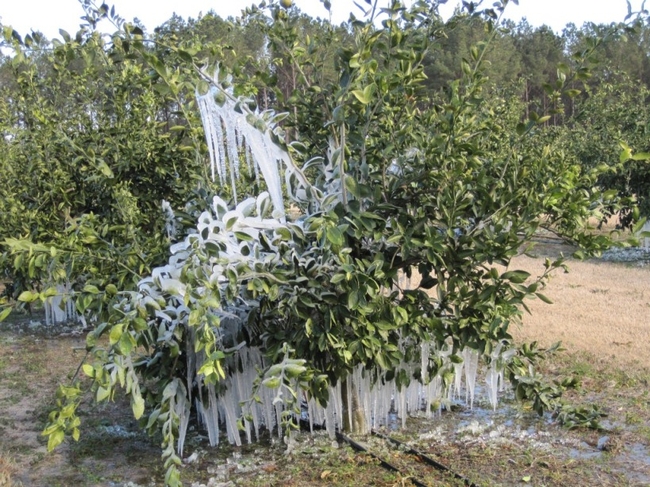Confronted with approaching freezing conditions a grower has several options to mitigate the potential cold damage. There are foliar sprays like copper that can reduce the incidence and need to be applied several weeks in advance of cold. There are orchard heaters that are still allowed in some growing areas but tend to be expensive to run due to fuel costs. There are wind machines that are capable, but less effective on avocado hillsides that have natural air movement. Then there is irrigation.
Of course you need healthy, well-watered trees to protect, otherwise, it is probably not worth the effort. And you need water that is dispersed in the air. Drip is much reduced in efficacy compared to microsprinklers and much less than high pressure overhead sprinklers. And you need water volumes that can be used continuously over the protected area during the freezing period.
Using irrigation water in frost control is a delicate balance among different physical characteristics of water. When it freezes, from a liquid state to the solid ice state, heat is released. More than what is actually making up the temperature of the liquid water. But then, in its liquid state, it starts evaporating turning to a gas which cools the surroundings. Heat from liquid to solid and cooling from liquid to gas. There's another property of water which is that it conducts heat really well, better than solid earth. So, wet soil heats up better from the daytime sun than a dry one.
So, you want to make sure the soil is moist during the day to soak up the heat. Then, you don't want water being applied after sunset to avoid evaporative cooling. Then when the trigger temperature for freezing occurs, the system should be run continuously so that heat is released during the freezing cycle. If you stop the water, then evaporative cooling kicks in and it could be colder than it would be if you had not run the water. And sometimes the emitters freeze up if they are turned off, and then they don't function when you try to come back around.
So, with that, you need to decide how much water you can run continuously in a given area. So, what is the coldest spot, and can you cover that area continuously for the cold period? Or the reverse is, if you know the cold area is going to get really cold and it may not make it through the cold even with irrigation, what is the area you want to protect that you know can be helped with irrigation? The water needs to run continuously. You don't want to be turning it on and off in order to roll it over to other irrigation blocks. When the water is turned off, the air starts cooling from evaporation. So decide how much area can be watered with the given volume.
Knowing all this you start watching for the cold with low temperatures that show 32 or lower. Older trees with canopies to the ground can handle more cold than young trees with little canopy to retain heat. Watch for the dew point. If it shows something much below 32, like 25, that means the air is dry and there will be a rapid temperature drop once temperatures start heading for the low temperature.
So, you are forewarned. Get water on to the grove to make sure the trees are adequately hydrated. Then a couple of days before the freeze event, make sure the surface soil is wetted during the day to take advantage of daytime heat, but make sure the water is off before sunset. Then when the big night hits, when temperatures hit a trigger temperature like 33 or 34, you should start the water. You want to have the system going before it drops below 32. Run the system until sunrise, and then you can most likely shut down. And wait for the next night and follow the same drill. We often will have two to three nights in a row that need protection.
Hopefully there's enough water for successive nights. And hopefully, it's not so much that root rot becomes an issue. Isn't farming fun?
